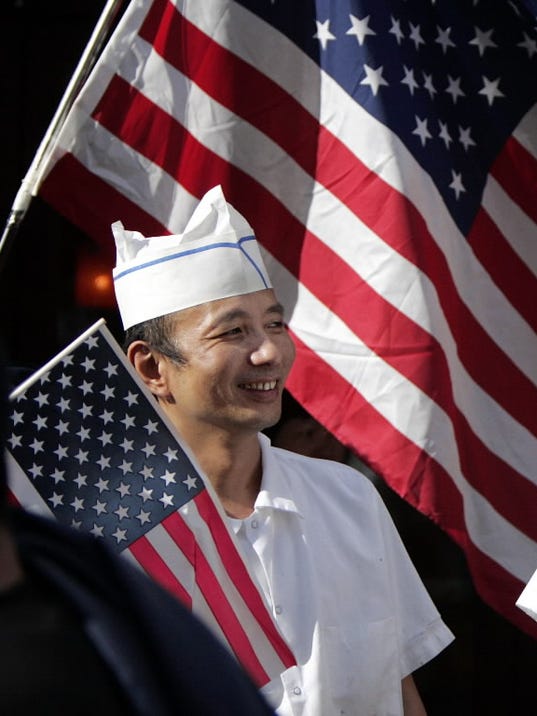Chinese immigrants
Chinese immigrants now largest arrivals to the US in 2013
|| 推荐到群组
Once singled out for exclusion by law from the United States, Chinese immigrants now make up the largest single group of arrivals a year into this country. The Census Bureau says China replaced Mexico as the top country of origin for immigrants to the U.S. in 2013.
Given the history, this growth – and the fact that Chinese immigrants are considered part of the Asian-American "model minority" – seems improbable. But the story of Chinese immigration, past and present reminds how fickle our attitudes about immigrants can prove.
On the wrong side of history
Although many of today's Chinese immigrants are students and investors, earlier Chinese immigrants were considered the lowest of the low-skilled.. Chinese sailors were among the crew on a ship that arrived in Baltimore in 1784. Chinese immigrants were living in New York City in the 1830s. And Chinese were among the thousands of gold seekers who rushed into California during the Gold Rush in the mid-19th century. By 1870, there were 64,000 Chinese in the United States, most of them in California, and almost all of them from the Pearl River Delta outside Guangzhou in southern China.
These Chinese immigrants faced a tremendous hostility, despite amounting to only a small fraction of the total foreign-born population in the United States in the late 19th century. They were charged with taking away jobs, corrupting white women, and threatening American civilization. In 1882, the U.S. passed the Chinese Exclusion Act, which barred Chinese laborers, prohibited all Chinese immigrants from becoming naturalized citizens, and allowed only select classes of Chinese to apply for admission.
While the act was in effect – from 1882 to 1943 – Chinese immigrants became America's first "illegal" immigrants. Chinese immigration drastically dropped, though it never totally stopped. Many of those who came resorted to false papers (like my own grandfather). Those who. arrived in San Francisco faced harsh interrogations, humiliating medical examinations, and long detentions in the unsanitary barracks on Angel Island in San Francisco Bay.
An end to selective immigration
In the past 50 years, Chinese immigration has undergone a dramatic transformation. The 1965 immigration Act ended national origins quotas favoring immigration from Europe over other parts of the world; it also established preferences for professional and skilled workers. At the same time, China's subsequent economic modernization and global outlook revived and diversified the flow of immigration from China.
In 1960, there were just under 100,000 Chinese-born immigrants in the United States. In 2010, the Census reported over 3.3 million adult Chinese-Americans. As of that year,, Chinese Americans had higher median annual personal earnings than the general U.S. population.
How far have we really come?
While Chinese immigrants may not be scrutinized in the same way that undocumented low-skilled Mexican immigrants are,, it would be wrong to assume that America has fully embraced Chinese and other Asian immigrants. Some Americans resent having to go to a doctor who has a foreign accent, for example, or having their kids compete with talented foreign-born (and second generation Asian-American) students for college admissions or jobs.
There could be even more resentment if China's national wealth and strength becomes more pronounced, and more explicitly opposed to American interests. This country has often treated immigrants unfairly based on the actions of their countries of origin. In 1999, Chinese-American scientist Wen Ho Lee was unfairly accused of spying for the People's Republic of China. Could there be more episodes like this in the near future?
As Chinese immigrants have gone from being the most excluded immigrants to the most numerous, we should recognize what has changed and what has not. Chinese immigrants and Chinese-Americans are growing in number. They are often held up as America's "good" immigrants. But they and other Asian-Americans remain vulnerable to anxieties, economic shifts and political struggles. How far have Chinese Americans really risen? And during a time of increasing xenophobia and concern about a newly powerful China worldwide, how easily might they fall?
Erika Lee is a historian and writer and director of the Immigration History Research Center at the University of Minnesota. Her most recent book, The Making of Asian America: A History will be published in September. She wrote this for What It Means to Be American a national conversation hosted by the Smithsonian and Zocalo Public Square.
In addition to its own editorials, USA TODAY publishes diverse opinions from outside writers, including our Board of Contributors. To read more columns like this, go to theOpinion front page.
http://blog.sciencenet.cn/blog-847277-903722.html 此文来自科学网李胜文博客,转载请注明出处。
